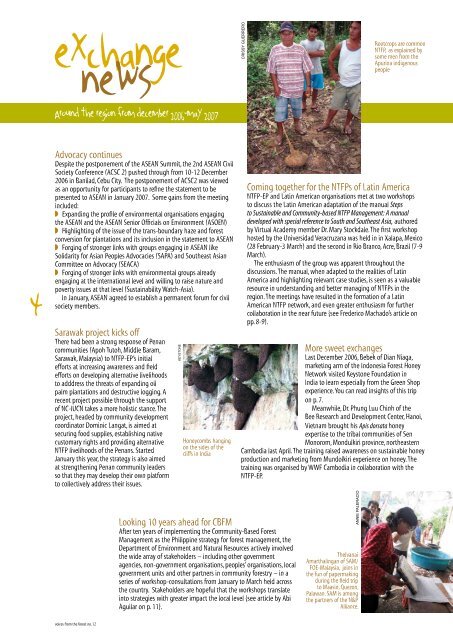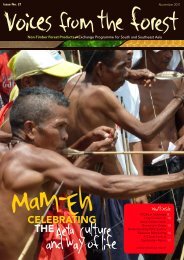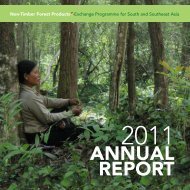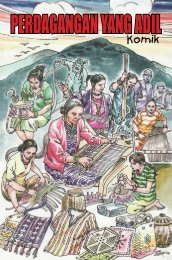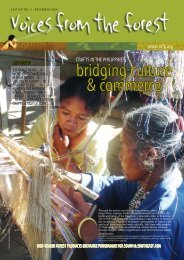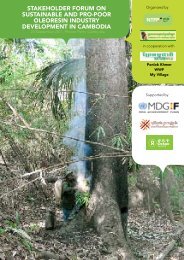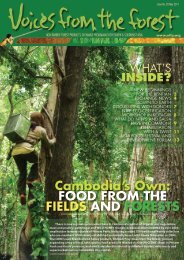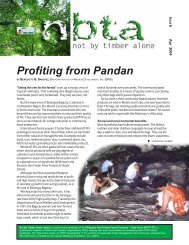Edition No. 12 - Non-Timber Forest Products Exchange Programme
Edition No. 12 - Non-Timber Forest Products Exchange Programme
Edition No. 12 - Non-Timber Forest Products Exchange Programme
You also want an ePaper? Increase the reach of your titles
YUMPU automatically turns print PDFs into web optimized ePapers that Google loves.
CRISSY GUERRERORootcrops are commonNTFP, as explained bysome men from theApurina indigenouspeopleAdvocacy continuesDespite the postponement of the ASEAN Summit, the 2nd ASEAN CivilSociety Conference (ACSC 2) pushed through from 10-<strong>12</strong> December2006 in Banilad, Cebu City. The postponement of ACSC2 was viewedas an opportunity for participants to refine the statement to bepresented to ASEAN in January 2007. Some gains from the meetingincluded:Expanding the profile of environmental organisations engagingthe ASEAN and the ASEAN Senior Officials on Environment (ASOEN)Highlighting of the issue of the trans-boundary haze and forestconversion for plantations and its inclusion in the statement to ASEANForging of stronger links with groups engaging in ASEAN likeSolidarity for Asian Peoples Advocacies (SAPA) and Southeast AsianCommittee on Advocacy (SEACA)Forging of stronger links with environmental groups alreadyengaging at the international level and willing to raise nature andpoverty issues at that level (Sustainability Watch-Asia).In January, ASEAN agreed to establish a permanent forum for civilsociety members.Sarawak project kicks offThere had been a strong response of Penancommunities (Apoh Tutoh, Middle Baram,Sarawak, Malaysia) to NTFP-EP’s initialefforts at increasing awareness and fieldefforts on developing alternative livelihoodsto adddress the threats of expanding oilpalm plantations and destructive logging. Arecent project possible through the supportof NC-IUCN takes a more holistic stance. Theproject, headed by community developmentcoordinator Dominic Langat, is aimed atsecuring food supplies, establishing nativecustomary rights and providing alternativeNTFP livelihoods of the Penans. StartedJanuary this year, the strategy is also aimedat strengthening Penan community leadersso that they may develop their own platformto collectively address their issues.KEYSTONEHoneycombs hangingon the sides of thecliffs in IndiaComing together for the NTFPs of Latin AmericaNTFP-EP and Latin American organisations met at two workshopsto discuss the Latin American adaptation of the manual Stepsto Sustainable and Community-based NTFP Management: A manualdeveloped with special reference to South and Southeast Asia, authoredby Virtual Academy member Dr. Mary Stockdale. The first workshophosted by the Universidad Veracruzana was held in in Xalapa, Mexico(28 February-3 March) and the second in Rio Branco, Acre, Brazil (7-9March).The enthusiasm of the group was apparent throughout thediscussions. The manual, when adapted to the realities of LatinAmerica and highlighting relevant case studies, is seen as a valuableresource in understanding and better managing of NTFPs in theregion. The meetings have resulted in the formation of a LatinAmerican NTFP network, and even greater enthusiasm for furthercollaboration in the near future {see Frederico Machado’s article onpp. 8-9).More sweet exchangesLast December 2006, Bebek of Dian Niaga,marketing arm of the Indonesia <strong>Forest</strong> HoneyNetwork visited Keystone Foundation inIndia to learn especially from the Green Shopexperience. You can read insights of this tripon p. 7.Meanwhile, Dr. Phung Luu Chinh of theBee Research and Development Center, Hanoi,Vietnam brought his Apis dorsata honeyexpertise to the tribal communities of SenMonorom, Mondulkiri province, northeasternCambodia last April. The training raised awareness on sustainable honeyproduction and marketing from Mundolkiri experience on honey. Thetraining was organised by WWF Cambodia in collaboration with theNTFP-EP.Looking 10 years ahead for CBFMAfter ten years of implementing the Community-Based <strong>Forest</strong>Management as the Philippine strategy for forest management, theDepartment of Environment and Natural Resources actively involvedthe wide array of stakeholders – including other governmentagencies, non-government organisations, peoples’ organisations, localgovernment units and other partners in community forestry – in aseries of workshop-consultations from January to March held acrossthe country. Stakeholders are hopeful that the workshops translateinto strategies with greater impact the local level {see article by AbiAguilar on p. 11}.ANNIE PALERACIOThelvanaiAmarthalingan of SAM/FOE-Malaysia, joins inthe fun of papermakingduring the field tripto Maasin, Quezon,Palawan. SAM is amongthe partners of the N&PAlliance.voices from the forest no. <strong>12</strong>


